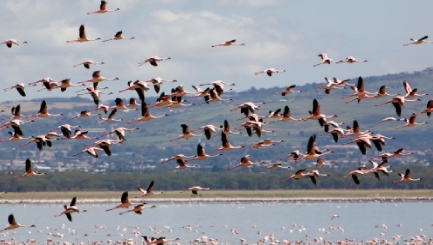Flamingos mating habits at risk
 East Africa plays host to around 75 percent of the world’s population of flamingos, with Lake Natron being the most prominent breeding ground for thousands of flamingo pairs. During mating season, around 2.5 million of these fascinating birds settle here but 2012 has been the most significant breeding period in recent years. Though a mass of birds have gathered here to procreate, there are construction plans that could place an industrial plant over the lake.
East Africa plays host to around 75 percent of the world’s population of flamingos, with Lake Natron being the most prominent breeding ground for thousands of flamingo pairs. During mating season, around 2.5 million of these fascinating birds settle here but 2012 has been the most significant breeding period in recent years. Though a mass of birds have gathered here to procreate, there are construction plans that could place an industrial plant over the lake.
These unique birds are famous for being mobile and generally explore a range of feeding grounds. The lesser flamingo, a more common species, tends to feed on the blue green algae that is found in salty lakes. Breeding grounds are more stable though and are not as interchangeable as where they feed – areas such as Lake Natron are used year after year for the ritual of mating and laying eggs.
Flamingos need stability – building their nests near the centre of the lake, they require a delicate balance of water to keep them safe, which can be disrupted by factors such as too much rainfall and predators that surround the lake. The plans to build a soda-ash extracting facility on Lake Natron could severely damage the mating rituals of the lesser flamingo population. The mining of soda ash creates more water which dilutes the dense mud which flamingos use to build their egg nests. This can become a serious problem – the breeding colony can be very nervous and have been known to desert their young if something disturbs the surrounding area.
Wetland areas elsewhere are also under threat, which poses the question of what will happen to the flamingo population across the globe. As the agricultural industry grows, vast areas of unprotected land will be used, causing damage not only to wildlife but also global warming and climate change.


Comments are closed.